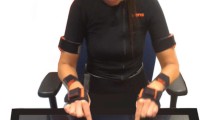Abstract
Control of voluntary movements is a dual structure of cognitive and physical controls. Cognitive control involves attentional resources, whereas physical control does not. In this study, we evaluated the dependency on attentional resources while learning to perform physical exercises using the relationship between the attentional resources and fluctuations in body movements. The physical exercise to be learned is the process of writing certain Chinese characters by hand. Detrended fluctuation analysis was applied to the analysis of body movement fluctuations in this study. We herein propose an index that qualitatively evaluates fluctuations locally on a timescale and includes a general scaling index on the detrended fluctuation analysis. We investigate and analyze the fluctuation characteristics in the handwriting process of three Kanji characters using this index. Moreover, we examine the relationship among the six handwriting time elements defined in the handwriting process, the handwriting difficulty of the three Kanji characters, and the timescale.








Similar content being viewed by others
Explore related subjects
Discover the latest articles, news and stories from top researchers in related subjects.References
Miyake Y, Onishi Y, Pöppel E (2007) Two types of anticipatory-timing mechanism in synchronization tapping, object recognition, attention, and action. Springer, New York, pp 231–244
Komatsu T, Miyake Y (2005) Time evolution of asynchronous value in synchronization tapping task (in japanese). SICE 41(6):518–526
Maleki A, Oshima Y, Nozawa A, Mizuno T, Uchida M (2015) Analysis of fluctuation in repeated handwriting based on psychophysiological factors. In: 7th International Conference on Unsolved Problems on Noise, 21
Kumagai R, Uchida M (2017) Detrended fluctuation analysis of repetitive handwriting. In: 2017 International Conference on Noise and Fluctuations, pp. 350–353
Kumagai R, Uchida M (2018) Fluctuation analysis of synchronous repetitive handwriting. In: 8th International Conference on Unsolved Problems on Noise, poster
Mandelbrot BB, Wallis JR (1969) Some long-run properties of geophysical records. Water Resour Res 5(2):321–340
Hardstone R, Poil S-S, Schiavone G, Jansen R, Nikulin VV, Mansvelder HD, L-Hansen, K (2012) Detrended fluctuation analysis: a scale-free view on neuronal oscillations. Front Physiol 3(450):1–13
Peng CK, Havlin S, Stanley HE, Goldberger AL (1995) Quantification of scaling exponents and crossover phenomena in nonstationary heartbeat time series. CHAOS 5(1):82–87
Curran SL, Andrykowski MA, Studts JL (1995) Short form of the Profile of Mood States (POMS-SF): psychometric information. Psychol Assess 7(1):80–83
Spielberger Charles D, Gorsuch Richard L, Lushene Robert E (1970) STAI manual for the State-trait anxiety inventory (self-evaluation questionnaire). Consulting Psychologists Press, Washington, D.C
Acknowledgements
This work was supported by JSPS KAKENHI Grant-in-Aid for Scientific Research (C) Number 17K00477. The authors would like to thank Enago (www.enago.jp) for the English language review.
Author information
Authors and Affiliations
Corresponding author
Additional information
This work was presented in part at the 24th International Symposium on Artificial Life and Robotics, Beppu, Oita, January 23–25, 2019.
About this article
Cite this article
Tanaka, K., Arai, K. & Uchida, M. Evaluation of task difficulty based on fluctuation characteristics in writing task. Artif Life Robotics 25, 17–23 (2020). https://doi.org/10.1007/s10015-019-00570-w
Received:
Accepted:
Published:
Issue Date:
DOI: https://doi.org/10.1007/s10015-019-00570-w




